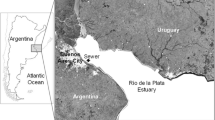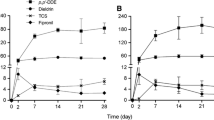Abstract
Polychlorinated dibenzo-para-dioxins (PCDDs) and dibenzofurans (PCDFs) were measured in the tissues of the estuarine clamRangia cuneata at four sites in the Neches River that had been subjected to paper mill effluent and at two remote sites. One of the river samplings was taken before dioxin control measures and another 2 yr after the control measures began. Measurable concentrations of PCDD/Fs were present at all sites, but higher concentrations were present at the Neches River sites. Whole tissue concentrations of 2,3,7,8-tetrachlorodibenzo-para-dioxin (TCDD) and all PCDD congeners for the two collections were not significantly different (p>0.05), but lipid-normalized concentrations for the two collections were significantly different (p<0.05). Highest concentrations of PCDDs at sites located 8 km and 16 km upriver from the paper mill effluent outfall indicated that the materials were transported upriver by saltwater intrusion and/or that nonpoint sources existed upriver. The presences of PCDD/Fs in clam tissues from the remote sites also indicated that other sources of these materials existed. Even under extreme physiological conditions (spent reproductive phase, low lipid contents, water temperature 10°C; ripe reproductive phase, high lipids, water temperature 32°C)Rangia cuneata was an effective biomonitor to determine the distribution of PCDD/Fs at specific sites. *** DIRECT SUPPORT *** A01BY069 00021
Similar content being viewed by others
Literature Cited
Amendola, G., D. Barna, R. Blosser, L. E. LaFleur, A. McBride, F. Thomas, T. Tiernan, andR. C. Whittemore. 1989. The occurrence and fate of PCDDs and PCDFs in five bleached kraft pulp and paper mills.Chemosphere 18:1181–1188.
Bender, M. E., P. O. DeFur, and R. J. Huggett. 1986. Polynuclear aromatic hydrocarbon monitoring in estuaries utilizing oysters, brackish water clams and sediments, p. 791–796.In Institute of Electrical and Electronic Engineer Oceans 1986 Conference Proceedings. Washington, D.C.
Bozzelli, J. W., G. W. Yo-ping, andE. R. Ritter. 1991. Thermodynamic insights on pathways to formation of chlorinated dioxins and dibenzofurans.Chemosphere 23:1221–1232.
Cain, T. D. 1975. Reproduction and recruitment of the brackish water clamRangia cuneata in the James River, Virginia.Fishery Bulletin 73:412–430.
Chaiyarach, S., V. Ratananun, andR. C. Harrel. 1975. Acute toxicity of the pesticides Toxaphene and Carbaryl and the herbicides Propanil and Mollinate to four species of aquatic organisms.Bulletin of Environmental Contamination and Toxicology 14:281–284.
Crocker, P. A. and C. Young. 1990. Tetrachlorodibenzo-p-dioxins and-dibenzofurans in edible fish tissue at selected sites in Arkansas, Louisiana, and Texas. United States Environmental Protection Agency Region 6 Report, Dallas, Texas.
Eisler, R. 1986. Dioxin hazards to fish, wildlife, and invertebrates: A synoptic review. United States Fish and Wildlife Service Biological Report 85(1.8). Washington, D.C.
Esposito, M. P., T. O. Tiernan, andF. E. Dryden. 1980. Dioxins. United States Environmental Protection Agency. Cincinati, Ohio. EPA-600/2-80-197.
Fisher, W. L., L. F. Brown, Jr. andC. G. Grout. 1973. Environmental geologic atlas of the Texas Coastal Zone-Beaumont-Port Arthur area. Bureau of Economic Geology, University of Texas, Austin, Texas.
Gallagher, J. L. andH. W. Wells. 1969. Northern range extension and winter mortality ofRangia cuneata.Nautilus 83: 22–25.
Hahn, M. E., A. Poland, E. Glover, andJ. J. Stegeman. 1992. The Ah receptor in marine animals: Phylogenetic distribution and relationship to cytochrome PA501A inducibility.Marine Environmental Research 34:87–92.
Harrel, R. C. 1975. Water quality and salt water intrusion in the lower Neches River.Texas Journal of Science 26:107–117.
Harrel, R. C. 1993. Origin and decline of the estuarine clamRangia cuneata in the Neches River, Texas.American Malacological Bulletin 10:153–159.
Harrel, R. C., J. Ashcraft, R. Howard, andL. Patterson. 1976. Stress and community structure of macrobenthos in a Gulf Coast riverine estuary.Contributions in Marine Science 20: 69–81.
Harrel, R. C. andM. A. Hall, III. 1991. Macrobenthic community structure before and after pollution abatement in the Neches River estuary, Texas.Hydrobiologia 211:241–252.
Harrel, R. C., M. McConnell, R. Masters, and R. Roller. In press. Effect of the reproductive cycle on osmoregulation and survival of the estuarine clamRangia cuneata. American Malacological Bulletin.
Havlik, M. E. and L. L. Marking. 1987. Effects of contaminants on naiad mollusks (Unionidae): A review. United States Fish and Wildlife Service Resource Publication 164, Washington, D.C.
Hayton, A., D. Hollinger, C. Tashiro, andE. Reiner. 1990. Biological monitoring of chlorinated dibenzo-dioxins in the Rainy River using introduced mussels (Elliptio complanata).Chemosphere 20:1687–1693.
Hopkins, S. H., J. W. Anderson, and K. Hovath. 1973. The brackish water clamRangia cuneata as an indicator of ecological effects of salinity changes in coastal waters. United States Army Corps of Engineers Waterways Experimental Station Report No. DACW39-71-C0007. Vicksburg, Mississippi.
Johnson, R. K., T. Wiederholm, andD. M. Rosenberg. 1993. Freshwater biomonitoring using individual organisms, populations, and species assemblages of benthic macroinvertebrates, p. 40–125.In D. M. Rosenberg and V. H. Resh (eds.), Freshwater Biomonitoring and Benthic Macroinvertebrates. Chapman & Hall, New York.
Jovanovich, M. C. andK. R. Marion. 1989. Gametogenic cycle ofRangia cuneata (Mactridae, Mollusca) in Mobile Bay, Alabama, with comments on geographic variation.Bulletin of Marine Science 45:130–138.
LaSalle, M. W. and A. de la Cruz. 1985. Species profiles: Life histories and environmental requirements of coastal fishes and invertebrate (Gulf of Mexico): Common rangia. United States Fish and Wildlife Service Report 82(11.32). United States Army Corps of Engineers, TR EL-82-4. Vicksburg, Mississippi.
Lunsford, C. A. andC. R. Blem. 1982. Annual cycle of Kepone residue and lipid content of the estuarine clam,Rangia cuneata.Estuaries 5:121–130.
Mason, C. E. 1991. Biology of Freshwater Pollution. Longman Scientific & Technical New York.
Mazer, T., F. D. Hileman, R. W. Noble, M. D. Hale, andJ. J. Brooks. 1983. Characterization of tetrachlorodibenzofurans, p. 23–72.In G. Choudhary, L. H. Keith, and C. Rappe (eds.), Chlorinated Dioxins and Dibenzofurans in the Total Environment. Butterworth Publishers. Boston, Massachusetts.
McConnell, M. A. 1993. Accumulation of heavy metals by the estuarine clamRangia cuneata under laboratory and field conditions. M.S. Thesis, Lamar University, Beaumont, Texas.
McMahon, R. F. 1991. Mollusca: Bivalvia, p. 315–399.In J. H. Thorp and A. P. Covish (eds.) Ecology and Classification of North American Freshwater Invertebrates. Academic Press, San Diego.
Merriman, J. C., D. H. J. Anthony, J. A. Kraft, andR. J. Wilkinson. 1991. Rainy River water quality in the vicinity of bleached kraft mills.Chemosphere 23:1605–1615.
Morrison, A. D. 1985. Dioxins in Canada—Deciding the public health risk, p. 39–53.In M. A. Kamrin and P. W. Rodgers (eds.). Dioxins in the Environment. Hemisphere Publishing, New York.
Neff, L. M., B. A. Cox, D. Dixit, andJ. W. Anderson 1976. Accumulation and release of petroleum-derived aromatic hydrocarbons by four species of marine animals.Marine Biology 38:279–289.
Olsen, L. A. 1976. Ingested material in two species of estuarine bivalves:Rangia cuneata (Gray) andPolymesoda caroliniana (Bosc).Proceedings of the National Shellfisheries Association 66: 103–104.
Olsen, K. R. andR. C. Harrel. 1973. Effects of salinity on acute toxicity of mercury, copper and chromium forRangia cuneata (Pelecypoda: Mactridae).Contributions in Marine Science 17:9–13.
Stolzenburg, T. and J. Sullivan. 1984. Dioxins: A Cause for Concern? University of Wisconsin Sea Grant Institute Publication No. WIS-SG-83-141, Madison, Wisconsin.
Swingle, H. A. andD. G. Bland. 1974. Distribution of the estuarine clamRangia cuneata Gray in coastal waters of Alabama.Alabama Marine Resource Bulletin 10:6–16.
Tenore, K. E., D. B. Horton, andT. W. Duke. 1968. Effects of bottom substrate on the brackish water bivalve.Rangia cuneata. Chesapeake Science 9:99–102.
Tiernan, T. O. 1983. Analytical chemistry of polychlorinated dibenzo-p-dioxins and dibenzofurans: A review of current status, p. 211–257.In G. Choudhary, L. H. Keith, and C. Rappe (eds.), Chlorinated Dioxins and Dibenzofurans in the Total Environment. Butterworth Publishers, Boston, Massachusetts.
Traver, J. W. 1972. Occurrence, distribution, and density ofRangia cuneata in Lake Pontchartrain and Lake Maurepas, Louisiana. Louisiana Wildlife and Fisheries Commission, Technical Bulletin No. 1. Baton Rouge, Louisiana.
United States Environmental Protection Agency. 1990. Revision. Method 8290 polychlorinated dibenzodioxins (PCDDs) and polychlorinated dibenzofurans (PCDFs) by high-resolution gas chromatography/high resolution mass spectrometry (HRGC/HRMS), p. 8290-1–8290-69.In Test Methods for Evaluating Solid Waste, Physical/Chemical Methods, SW-846, 3rd Edition, 1986. United States Environmental Protection Agency, Cincinnati, Ohio.
United States Environmental Protection Agency. 1991. Water programs; Guidelines establishing test procedures for the analysis of pollutants.Federal Register 56:5090–5122.
United States Environmental Protection Agency. 1992. National study of chemical residues in fish. United States Environmental Protection Agency, EPA 823-R-92-008a & b. Washington, D. C.
United States Environmental Protection Agency. 1992. Interim report on data and methods for assessment of 2,3,7,8-tetrachlorodibenzo-p-dioxin risks to aquatic life and associated wildlife. United States Environmental Protection Agency, EPA/600/R-93/055. Duluth, Minnesota.
Wolfe, D. A. andE. N. Petteway. 1968. Growth ofRangia cuneata Gray.Chesapeake Science 9:99–102.
Author information
Authors and Affiliations
Rights and permissions
About this article
Cite this article
Harrel, R.C., McConnell, M.A. The estuarine clamRangia cuneata as a biomonitor of dioxins and furans in the Neches River, Taylor Bayou, and Fence Lake, Texas. Estuaries 18, 264–270 (1995). https://doi.org/10.2307/1352637
Received:
Accepted:
Issue Date:
DOI: https://doi.org/10.2307/1352637




